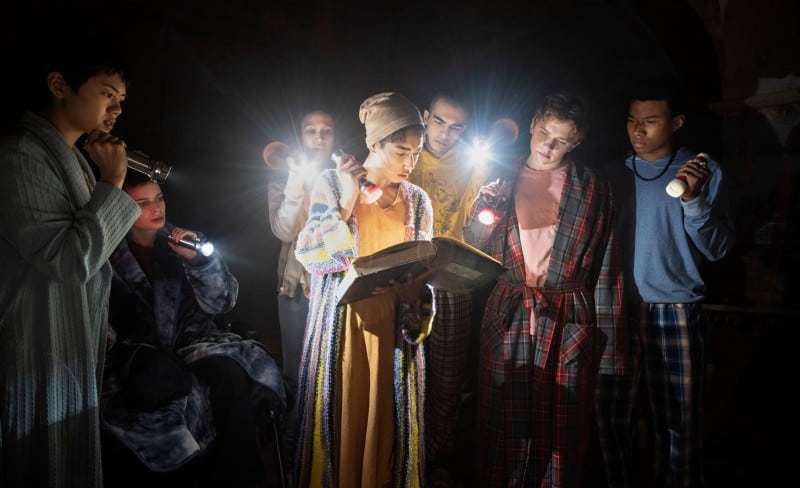
Halloween season on Netflix belongs to Mike Flanagan. In 2018, the horror filmmaker took over the zeitgeist for the month of October with the thrilling and emotional limited series The Haunting of Hill House. Since then, he’s presented ambitious and deeply felt horror projects on the streamer nearly every fall, including last year’s sweeping religious vampire saga Midnight Mass. Now, Flanagan returns with The Midnight Club, a young adult-led series with hints of horror, mystery, dark academia, and anthology. Creative, suspenseful, and endearingly moralizing in the tradition of shows like The Twilight Zone, The Midnight Club is another can’t-miss from the filmmaker who often feels like Stephen King’s storytelling heir apparent.
Co-created by Leah Fong (who produced The Haunting of Bly Manor) based on the book by Christopher Pike, The Midnight Club follows a group of teens and young adults who meet in a small, privately-run hospice in 1994. Each one is terminally ill, but they’re also brilliantly unique, from chipper compulsive liar Cheri (Adia) to super-religious Sandra (Annarah Cymone) to caustic, pill-popping Irish girl Anya (Ruth Codd). The series’ protagonist is Ilonka (Iman Benson), a high achiever whose college-thwarting diagnosis leads her to purposely seek out the secrets of Rotterdam Home, a place that’s rumored to have cured past residents.
While The Midnight Club isn’t a pure anthology – the hospice-set plots are much more than just a frame narrative – it does include self-contained stories in the form of the eight-member club that meets at midnight to tell ghost stories and tall tales. Many of these stories pull directly from Pike’s books and feature vastly different genre influences and tones. From a metaphorical highway to hell to a VHS that predicts the future, they’re also stories that clearly provide from Rod Serling’s tradition of compassionate, twisty sci-fi and horror. Rather than telling viewers something about the world, though, each tale tells us something important about its narrator, giving a small but vital piece of autonomy back to a group of characters whose own life stories are beyond their control.
As a story that’s largely about cancer, death, and the unknowable prospect of an afterlife, The Midnight Club is well-suited to Flanagan’s penchant for passionately monologuing characters. It makes sense for this ensemble, a bunch of smart teens cooped up in a place where they’re all but waiting to die, to deliver the words they haven’t been able to say before in a cascade of emotion. The series’ emotional tenor sometimes borders on overly earnest, but mostly it delivers genuine pathos. Even when its script gets a bit taxing, it feels like a purposeful stylistic choice in line with its co-creators established signatures–and with the vein of humanizing horror that clearly inspires him.
When it comes to scares, The Midnight Club might be lighter on them than any other Flanagan series. Teens don’t seem to be the primary audience of The Midnight Club (it’s rated TV-MA and is quite heavy), but it does lean into the fact that many of the horror tales it tells are made by teens. Ilonka references The Breakfast Club in the show’s first episode, and there’s a Hughsian quality to all of this, too: the stories are just as concerned with high school hierarchies as they are with death and darkness. Yet they’re definitely a feature, not a bug. Each story-in-a-story reconfigures the core cast in new roles, and several include welcome appearances from past Flanagan project alums.
When frightening moments do arrive, they’re often of the jump scare variety, telegraphed to audiences via the sudden appearance of a figure and the employment of disorienting, sharp sound design. This gets old quickly, but in a few select cases, works wonders. As with the Bent-Neck Lady in The Haunting of Hill House, The Midnight Club includes a few harrowing images made all the more disturbing by their existentially terrifying backstories.
There’s a lot to love in The Midnight Club, a sometimes dense and always ambitious saga that, excitingly, doesn’t actually purport to be a limited series. Among its greatest strengths is its cast, including Benson’s nuanced lead performance and a fiery and fantastic one by Codd. Ilonka may be the series lead, but Anya is its screaming, furious heart. An episode centered on her later in the season is no doubt the series’ best, and it’s the part I laid awake thinking about after the credits on all ten episodes had rolled.
The Midnight Club is also noteworthy for its thoughtful portrayal of disability. While its characters rail against death, they also help each other acclimate to their physical circumstances without question, communicating love through acts of accessibility as often as through words. By putting its characters’ own authorship front and center, The Midnight Club also asks us to think hard about the stories we’ve heard about the sick and dying. Ultimately, beyond its scares and mysteries, it acts as an intentional and continuous reclamation of the sick kid narrative, pushing beyond the surface to ask big questions about life, death, and the meaning we make from it.
Related Topics: Mike Flanagan, Netflix

